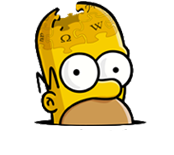
Difference between revisions of "Yokel Chords/References"
Wikisimpsons - The Simpsons Wiki
m (→Cultural references: replaced: {{W|Maria (Rodgers and Hammerstein song)|Maria}} → {{W2|Maria|Rodgers and Hammerstein song}} (6)) |
m (→Cultural references: replaced: {{W|The Honeymooners}} → The Honeymooners, {{W|The Sound of Music}} → The Sound of Music, {{W|The Sopranos}} → The Sopranos, {{W|Peter Bogdanovich}} → Peter Bogdanovich) |
||
| (One intermediate revision by the same user not shown) | |||
| Line 3: | Line 3: | ||
== Cultural references == | == Cultural references == | ||
| − | *The whole storyline involving Lisa shows many references to '' | + | *The whole storyline involving Lisa shows many references to ''[[The Sound of Music]]''. |
**When Lisa gets told she can be a tutor, she dances on a hill (similar to the opening sequence of the film) and when she introduces herself, Cletus' children walk forward and state their name (a reference to Maria's introduction to the children). | **When Lisa gets told she can be a tutor, she dances on a hill (similar to the opening sequence of the film) and when she introduces herself, Cletus' children walk forward and state their name (a reference to Maria's introduction to the children). | ||
**Some of the songs they sing are based on songs from the film: | **Some of the songs they sing are based on songs from the film: | ||
| Line 11: | Line 11: | ||
***"[[Moonshine Drinkers]]" is a parody of the song "{{W|Sixteen Going on Seventeen}}". | ***"[[Moonshine Drinkers]]" is a parody of the song "{{W|Sixteen Going on Seventeen}}". | ||
*In [[Marge]]'s dream, she suggests ''{{W|Little Bo-Peep}}'' for the title of a {{Ch|James Patterson}} book. | *In [[Marge]]'s dream, she suggests ''{{W|Little Bo-Peep}}'' for the title of a {{Ch|James Patterson}} book. | ||
| − | *The style of the artwork in the sequence in which Bart tells his classmates a story about a murderous cafeteria worker resembles the work of {{ | + | *The style of the artwork in the sequence in which Bart tells his classmates a story about a murderous cafeteria worker resembles the work of {{W|Edward Gorey}}. A piece of music is used in this scene that is reminiscent of a piece of {{W|Astor Piazzolla}}'s music from the suite "Punta del Este" used in the film ''{{W|Twelve Monkeys}}''. This same music is used later when Bart's psychiatrist sees her psychiatrist. The clip is also comparable to that of Stephen Sondheim's ''{{W2|Sweeney Todd|musical}}''. |
*[[Principal Skinner]] suggests giving Lisa a gift card from {{W|Gap Inc.|The Gap}} to shut her up. | *[[Principal Skinner]] suggests giving Lisa a gift card from {{W|Gap Inc.|The Gap}} to shut her up. | ||
| − | *The music played when Groundskeeper Willie rounds up the kids is the main title theme to the 1965 {{ | + | *The music played when Groundskeeper Willie rounds up the kids is the main title theme to the 1965 {{W|John Sturges}} film ''{{W|The Hallelujah Trail}}'', composed by {{W|Elmer Bernstein}}. |
| − | *The relationship Bart shares with his psychiatrist is reminiscent to the way that Tony Soprano and his psychiatrist form a unique bond, with Bart in depression wanting to see her, and the doctor wanting to see more of Bart. Dr. Swanson's psychiatrist also resembles the character of Dr. Elliot Kupferberg from '' | + | *The relationship Bart shares with his psychiatrist is reminiscent to the way that Tony Soprano and his psychiatrist form a unique bond, with Bart in depression wanting to see her, and the doctor wanting to see more of Bart. Dr. Swanson's psychiatrist also resembles the character of Dr. Elliot Kupferberg from ''[[The Sopranos]]'', who was Dr. Melfi's psychiatrist. [[Peter Bogdanovich]] plays both roles. |
| − | *The video game, ''Death Kill City II: Death Kill Stories'', played by Bart and the psychiatrist is a reference to the ''{{W2|Grand Theft Auto|series}}'' series of video games, notably the city stories prequels (''{{ | + | *The video game, ''Death Kill City II: Death Kill Stories'', played by Bart and the psychiatrist is a reference to the ''{{W2|Grand Theft Auto|series}}'' series of video games, notably the city stories prequels (''{{W|Liberty City Stories}}'' and ''{{W|Vice City Stories}}''). The rating for ''Death Kill City II'' is "Bad for Everyone," which spoofs the {{W|ESRB}} rating, "E for Everyone". |
*During "[[Cultural Things Experience]]": | *During "[[Cultural Things Experience]]": | ||
**[[Comic Book Guy]] sings about [[Salvador Dalí]], {{W|Edgar Degas}} and {{W|Joan Miró}}. | **[[Comic Book Guy]] sings about [[Salvador Dalí]], {{W|Edgar Degas}} and {{W|Joan Miró}}. | ||
| − | **The beginning of the {{ | + | **The beginning of the {{W|surrealist}} film, ''{{W|Un Chien Andalou}}'' is seen in a theater. |
**[[Agnes Skinner]] is in a performance of ''{{W2|Mame|musical}}''. | **[[Agnes Skinner]] is in a performance of ''{{W2|Mame|musical}}''. | ||
*Bart says he dreamed his whole family were cartoon characters and their success had led to ''[[Fox News]]''. | *Bart says he dreamed his whole family were cartoon characters and their success had led to ''[[Fox News]]''. | ||
*Krusty calls the Spuckler kids the "Smashing Bumpkins", a reference to the [[The Smashing Pumpkins]]. | *Krusty calls the Spuckler kids the "Smashing Bumpkins", a reference to the [[The Smashing Pumpkins]]. | ||
*Krusty told {{Ch|Stephen Sondheim}} to do what he did in ''[[Cats]]'', but Sondheim said he didn't write ''Cats''. | *Krusty told {{Ch|Stephen Sondheim}} to do what he did in ''[[Cats]]'', but Sondheim said he didn't write ''Cats''. | ||
| − | *The ending, with Cletus saying, "Baby, you're the greatest," Cletus and Brandine kissing, the pan to the skyline and moon, with Cletus's face, and the music are all a direct reference to the 50's sitcom '' | + | *The ending, with Cletus saying, "Baby, you're the greatest," Cletus and Brandine kissing, the pan to the skyline and moon, with Cletus's face, and the music are all a direct reference to the 50's sitcom ''[[The Honeymooners]]''. The theme song for the show, "You're My Greatest Love", plays over the end. |
== Goofs == | == Goofs == | ||
Latest revision as of 12:45, June 8, 2022
|
|||||||||
|
|
|
Cultural references[edit]
- The whole storyline involving Lisa shows many references to The Sound of Music.
- When Lisa gets told she can be a tutor, she dances on a hill (similar to the opening sequence of the film) and when she introduces herself, Cletus' children walk forward and state their name (a reference to Maria's introduction to the children).
- Some of the songs they sing are based on songs from the film:
- "Oh, How Do We?" is a parody of the song "Maria".
- "Motivate Them" is a parody of the song "The Sound of Music".
- "Cultural Things Experience" is a parody of the song "My Favorite Things".
- "Moonshine Drinkers" is a parody of the song "Sixteen Going on Seventeen".
- In Marge's dream, she suggests Little Bo-Peep for the title of a James Patterson book.
- The style of the artwork in the sequence in which Bart tells his classmates a story about a murderous cafeteria worker resembles the work of Edward Gorey. A piece of music is used in this scene that is reminiscent of a piece of Astor Piazzolla's music from the suite "Punta del Este" used in the film Twelve Monkeys. This same music is used later when Bart's psychiatrist sees her psychiatrist. The clip is also comparable to that of Stephen Sondheim's Sweeney Todd.
- Principal Skinner suggests giving Lisa a gift card from The Gap to shut her up.
- The music played when Groundskeeper Willie rounds up the kids is the main title theme to the 1965 John Sturges film The Hallelujah Trail, composed by Elmer Bernstein.
- The relationship Bart shares with his psychiatrist is reminiscent to the way that Tony Soprano and his psychiatrist form a unique bond, with Bart in depression wanting to see her, and the doctor wanting to see more of Bart. Dr. Swanson's psychiatrist also resembles the character of Dr. Elliot Kupferberg from The Sopranos, who was Dr. Melfi's psychiatrist. Peter Bogdanovich plays both roles.
- The video game, Death Kill City II: Death Kill Stories, played by Bart and the psychiatrist is a reference to the Grand Theft Auto series of video games, notably the city stories prequels (Liberty City Stories and Vice City Stories). The rating for Death Kill City II is "Bad for Everyone," which spoofs the ESRB rating, "E for Everyone".
- During "Cultural Things Experience":
- Comic Book Guy sings about Salvador Dalí, Edgar Degas and Joan Miró.
- The beginning of the surrealist film, Un Chien Andalou is seen in a theater.
- Agnes Skinner is in a performance of Mame.
- Bart says he dreamed his whole family were cartoon characters and their success had led to Fox News.
- Krusty calls the Spuckler kids the "Smashing Bumpkins", a reference to the The Smashing Pumpkins.
- Krusty told Stephen Sondheim to do what he did in Cats, but Sondheim said he didn't write Cats.
- The ending, with Cletus saying, "Baby, you're the greatest," Cletus and Brandine kissing, the pan to the skyline and moon, with Cletus's face, and the music are all a direct reference to the 50's sitcom The Honeymooners. The theme song for the show, "You're My Greatest Love", plays over the end.
Goofs[edit]
- In this episode, Cletus signs his name with an "x", despite previously displaying a rather elegant signature in "Sweets and Sour Marge".
